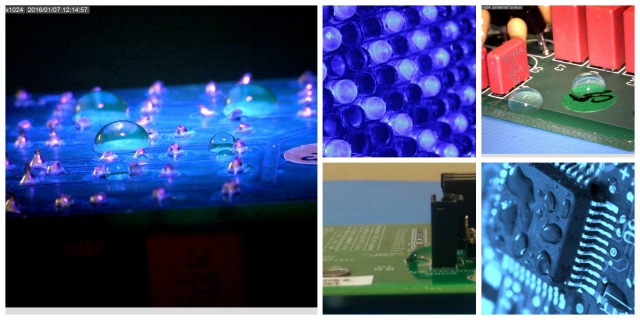
- What is a nano-coating?
- Why are nano-coatings used?
- What sectors are nano-coatings being used?
- What products are actually coated in nano-coatings?
- Why select a nano-coating?
- How is a nano-coating applied?
- Can the nano-coating replace a traditional conformal coating?
- Where are nano-coatings being used?
- How much does the nano coating process cost?
- What are five key differences between a fluoropolymer coating (FC) and a conformal coating for protecting an electronic printed circuit board or assembly?
Generally, a nano-coating is a fluoropolymer thin film comprised of fluorocarbons and characterised by carbon-fluorine bonds.
Chemically inert, fluorocarbons are not susceptible to Van der Waals force and this lends to their signature properties: non-stick and friction reducing (hydrophobic and, at 0.05-0.10, it has one of lowest coefficients of friction).
Owing to the fluorine bonds, fluoropolymers demonstrate a high level of durability as well as resistance to acids, bases and most solvents.
These fluoropolymer films have very specialised properties.
Properties include:
- Hydrophobic (water repellent)
- High moisture barrier
- Oleophobic (oil repellent)
- Chemical resistance
- High lubricity
- High dielectric properties
- Suitable for sterilization
- High corrosion resistance
- Good abrasion / wear resistance
Note, not all fluoropolymers have all of the above properties. But, some coatings can in fact have almost all of the properties.
The fluoropolymers are extremely flexible coatings and becoming more prolific throughout engineering.
What sectors are nano-coatings being used?
The coatings are used in almost all industrial and commercial electronic sectors.
They include:
- Aviation
- Aerospace
- Defense
- Automotive
- Industrial
- Oil & Gas
- Electronics
- Medical/Pharmaceutical
- Optics
- Telecommunications
- White goods / Commercial
This list is limited and there are a lot more areas that they are used.
What products are actually coated in nano-coatings?
Products coated with nano-coatings include:
- Circuit boards
- Mobile phones
- Tablets
- Automotive parts (gears, rotors, pistons)
- Commercial bake-ware
- Filters, filter housing
- Glassware, labware
- Machine parts/components
- Printing equipment
- Sintered metal parts
- Catheters, guidewires
- Fasteners
- Screen, mesh (metal/synthetic)
- Filter media (cloth, synthetic)
- O-rings, gaskets, seals
- Silicone rubber
- Solenoid, springs, coils
The nano-coatings do a different job to the traditional liquid conformal coatings.
What they do is effectively change the surface energy of the substrate they are applied to.
This change in surface energy makes it harder for liquids like water and oils to wet the surface and cause corrosion etc. water repelled from a connector due to a fluoropolymer conformal coating
A fluoropolymer nano-coating will repel water from a circuit board. Here the whole board is coated and the water is repelled from the component.
They are also ultra thin in nature. Typically, they are applied at 01.-2µm in thickness.
This means that generally you do not need to mask a circuit board with a nano coating. The film is so thin that the coating has no resistance when the connector parts are joined together.
Discuss your no masking conformal coating requirements with us now and discover the lowest cost process in conformal coating.
How is a nano conformal coating applied?
Since no masking is applied or required then the process time is extremely low. In fact, the only process time is the application process.
The simplest method of application for the no mask conformal coating is to dip the whole board into the material. Dipping multiple boards at one time means process time is also extremely low.
Once the board is withdrawn and the excess material is drained then the coating dries extremely quickly and the board is coated.
This means the process time is extremely short. Typical process times can be less than 30s.
This means that the longest time is loading and unloading the boards for the application process.
Discuss your no masking conformal coating requirements with us now and discover the lowest cost process in conformal coating.
Can a nano-coating replace a traditional conformal coating?
This depends on what you want the coating to do and how the circuit is handled.
Since the coating is ultra thin it does not have the same resistance to handling like a traditional coating. So, if you intend to handle the board a lot then it may not be suitable.
However, if you can minimise the handling the board then the fluoropolymer coating may be suitable for your process.
Also, if you have high breakdown voltages on the board the FC coating may not give you the same level of protection. So, you really need to test the technology to suit your process.
However, if you want a coating that repels oil and water then a fluoropolymer nano-coating could be ideal.
A circuit board with conformal coating applied on one end and a fluoropolymer coating on the other end. The water does not wet the circuit on the right.
A circuit with conformal coating applied on one side (left) and a fluoropolymer coating on the other (right). The water does not wet the circuit on the right.
Discuss your no masking conformal coating requirements with us now and discover the lowest cost process in conformal coating.
Where are nano coatings being used?
The coatings used for protecting circuit boards like a conformal coating are being used in many different areas including high volume communication technologies like mobile phones and tablets. Since they repel water they can help to make a circuit waterproof.
The fluoropolymer coatings are also being introduced to a variety of other areas including glass protection on mobile phones and tablets due to some of the coatings literally repelling finger print marks.
In fact, this technology is being used in more and more diverse areas as the material becomes popular in the market.
How much does the nano coating process cost?
The cost of the material per board is similar to the traditional conformal coating. However, there is no masking required in most cases.
So, the cost of processing goes down a lot and the process is extremely simple.
Discuss your no masking conformal coating requirements with us now and discover the lowest cost process in conformal coating.
Contact us now.
What are five key differences between a fluoropolymer coating (FC) and a conformal coating for protecting an electronic printed circuit board or assembly?
- Hydrophobic Properties – A fluoropolymer coating is generally hydrophobic in nature. It repels water when the water is on the surface of the coating.
- Extremely thin coating – The fluoropolymer coating is normally applied a lot thinner than a typical liquid conformal coating. This is due to its superior performance when repels liquids
- No masking – Due to the extremely thin fluoropolymer coating applied (<1-2um), the components that normally require protecting (connectors, switches etc) from the insulating liquid conformal coating may not need to be masked for the fluoropolymer. The circuit board can be completely submerged in the liquid with no masking applied without fear of damaging the connections.
- Simple process – No masking means an extremely fast application process
- Fast drying – due to the thin nature of the fluoropolymer coating and the solvents normally used the coating dries extremely quickly.
Interested in our range of nano-coatings?
Contact us now to discuss what we can offer you.
Give us a call at (+44) 1226 249019 or email your inquiries at sales@schservices.com.

